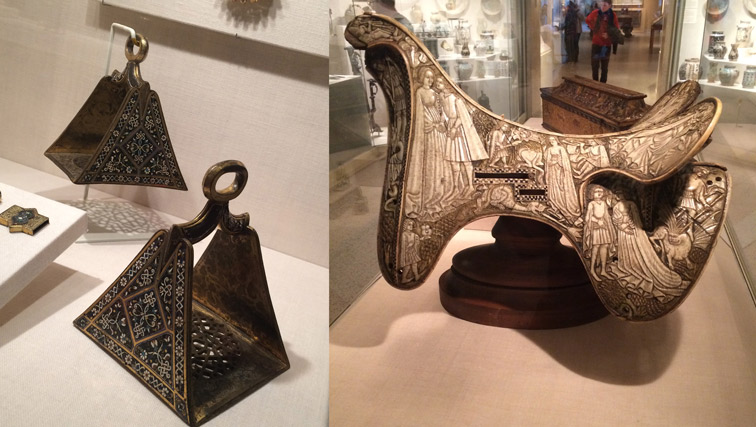Saddles, Stirrups and Goggles: Evolution of Racing Equipment

Equestrian gear has evolved noticeably over the years since the first saddles and first pair of jockey goggles to today’s modern versions. Here’s a bit of background on some of these transformations and how they impact racing today!
Saddles and Stirrups: The first “saddle” is believed be from around 700 B.C., when the Assyrian cavalry attached fringed cloth or pads to horses using a girth. Over time, stronger, padded and intricate designs, typically made to show a person’s status and wealth, were created and those evolved into the saddles we see today.
Saddles nowadays vary depending on material, fit and discipline.
15th CENTURY SADDLE MADE OF BONE, WOOD AND RAWHIDE AT THE METROPOLITAN MUSEUM OF ART
Photo by Victoria Garofalo
The first saddles were greatly improved upon during the Middle Ages, when knights needed extremely supportive and sturdy saddles. Eventually they branched off into the Western and English saddles we know today.
English saddles are those used in all of the Olympic equestrian disciplines — eventing, show jumping and dressage, plus hunt seat, saddle seat, horse racing and polo. French equestrian François Robinchon de la Guérinière created what would become the modern English saddle with a main emphasis on the three-point seat that is used today in dressage.
The Western saddle was brought to the Americas by the Spanish Conquistadors and adapted to the needs of cowboys. The horn was added so a lariat could be tied to hold livestock, which is why these are typically used in western riding activities and on working cattle ranches in the U.S.
ENGLISH AND WESTERN SADDLES
Photo by WikiMedia Commons
The stirrup wasn’t invented at the same time as the saddle, but the creation became a huge milestone for saddle use. It was initially used to help provide support for riders in the days of warfare and to aid in mounting, while also allowing the rider better control of their horse.
15th CENTURY STIRRUPS AT THE MET
Photo by Victoria Garofalo
The length of a stirrup determines its use – a shorter stirrup allows more mobility while longer models allow better control. The shortest of the short stirrups are those that Thoroughbred jockeys use. The short length allows jockeys to hover over a horse’s center as they move at the amazing maximum speeds we see at the racetrack.
COLLECTION OF SPURS, STIRRUPS, BITS, PENDANTS AND PLAQUES AT THE MET
Photo by Victoria Garofalo
Jockey Gear: Two of the most recognizable jockey-worn items are boots and goggles, both of which were patented by the same family.
The Kroop name has a long-standing history in the equine industry. Founder Adolph Kroop created the iconic jockey boot in the 1930s, and in 1947 his son Israel patented jockey goggles. The riding boot originally was created to prevent the saddle leather from pinching a rider’s leg, though modern riding boots come in countless styles, shapes and colors.
The boot that we see today came about because jockey Henry Erickson walked into Adolph Kroop’s Laurel, Md. store one day and asked if a special boot could be made to fit his tiny feet. They made him a custom pair, and the 125-step process they used is still the way they’re made today. You can even go into the store and see the original wooden shoe forms used to make many of the jockeys’ boots – including Shoemaker’s size 1 1/2.
It’s estimated that 65% of jockeys in the U.S. wear the Kroop brand.
A JOCKEY AND HIS BOOTS
Photo by WikiMedia Commons
As for jockey goggles, in the 1940s, jockeys were wearing bulky motorcycle goggles while riding, spurring a local jockey to stop into the Kroop boot shop and ask Israel Kroop if he could create an alternative. The jockey goggle – slimmer, lighter, and offering better peripheral vision while riding – was born.
COLORFUL KROOP JOCKEY GOGGLES AT AN ABR EVENT
The goggles are stackable, so when one pair gets covered in mud a jockey can swiftly remove the top pair and have a clean, new pair ready for use. Each pair of Kroop jockey goggles, said to be worn by the majority of riders in the world today, goes through a detailed 15-step process. For more of the Kroop story visit here and here.
Like a family’s coat of arms or a basketball team’s jerseys, jockey silks are a specific way to identify each horse’s owner. Chariot drivers in ancient Rome are said to be the first to don racing colors while competing, though individual silks colors were first recorded during the reign of Henry VIII. That custom later became popular during Charles II and Queen Anne’s reign.
As more people began to own horses, the need to differentiate became a more serious problem. In 1762 at Newmarket, the English Jockey Club requested owners submit specific cap and jacket colors. These colors were to be registered and consistently used in order to lessen confusion for both viewers and owners.
A SECTION OF THE SARATOGA SILKS ROOM
Photo by Victoria Garofalo
All New York racehorse owners must register their silks with The Jockey Club, but an owner can’t just have any silks. There are rules addressing the number of colors used, shapes and patterns and initials and emblems. You can see more jacket and sleeve registration designs here.
Just like horse racing, equestrian gear has a long and rich history as well as a colorful present. Not only is the equipment beautiful, but it’s incredible to see the intricate processes in which they were designed and created. From the days of bareback and chariot racing to now, these items have greatly evolved and help shape the sport of Thoroughbred racing that we know and love today.
